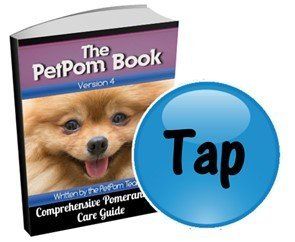Parti
PetPom
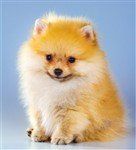
The
Pomeranian
Information
Center
Parti Pomeranians


Abby, at 10 months old; Photo courtesy of Belinda & Allen Hood
Overview
Since this breed can be found in so many different colors, naturally it is very common for a Pom to have more than one in his coat.
When there are two colors, this is referred to as 'parti' and technically white should be one of the colors.
The AKC 'prefers' that parti Pomeranians are white with another color. And a blaze (white running between the eyes and up over the forehead, as seen on this Pom (left; above on mobile) is preferred as well. Finally, in show ticking is not desired; ticking is a freckling of color on any white area.
If the 2nd color is one in which 'self-coloring' is expected with solids (chocolate has a chocolate nose, eye rim, lips and paws pads, blue has blue, beaver had beaver) it is expected with partis as well.
All others (orange, red, cream, white, etc.) should have black noses and black eye rims, lips and paw pads. Do keep in mind that
many
Poms do not fit what is desired in the show ring.
A parti Pomeranian may have a third color that may be little more than a tiny splash or may be quite visible such as a patches over the back. If just a splash, this may be classified as a marking and 'tri-color' is a choice when registering a pup.
Since the genes that create either solids or partis are strong, it is common for breeders to focus on just one or the other. Though, since color can easily come from 5 generations back and in some cases even further, you may find a litter of solids with 1 parti or a litter of partis with one solid.
This breed is known for morphing during his first year, with the puppy coat falling out and being replaced by the adult coat, therefore the percentages of color in a parti coat will most often be very different from puppy to adult. Of the two colors seen, one may decrease or grow in more and the shading of it may lighten or darken.
The Three Types of Parti Poms
There are 3 types of parti Poms when white is one of the colors:
1. Extreme Piebald Parti.
The Extreme Piebald Parti has a majority of white in the coat and a minority of any other color. With the extreme piebald, the base of the tail ‘should’ be white, per AKC conformation standards.
2. A Piebald Parti
- The Piebald Parti is a 50/50 mixture of 2 colors.
3.An Irish Mark Parti
- The Irish Mark Parti Pom will have more color than white. White will be a small splash, often on the chest. There may be small touches of white on the paws or ear tips as well.
Examples of These 3 Types:

This is an extreme piebald parti Pomeranian; most of the coat is white, another color is only seen just a bit; with this Pom on the head.
This particular dog's second color is merle (which is actually a type of marking, it is a splashed coloring and not seen that often, as only the AKC excepts this coloring). Therefore, this Pom is a merle
extreme piebald parti, which makes him exceptionally rare.
Viserion, Photo courtesy of Aleksandra
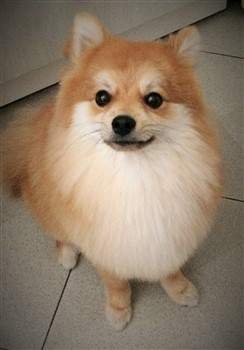
This is a classic piebald parti Pomeranian.
As you can see, white takes up roughly 50% of the coat; on this dog seen mostly on the chest but also coming up over the neck and lower face.
A touch of white is also seen on the paws. This particular Pom is an orange and white piebald parti.
Teddy, at 10 months old
Photo courtesy of Titi
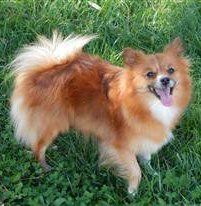
This is an Irish mark parti Pomeranian. With this sort of parti, white is seen only as a small marking, with the coat holding a different color as its main color.
While that small white can appear just about anywhere, it is commonly seen as it is on this Pom, a bit on the chest, paws and head.
While you always have to be ready for a Pomeranian to have his colors morph as he grows, this Pom is 4 years old, so what you see is the final adult coat.
Kayla Marie Diva, at 4 years old Photo courtesy of Jessi B.
Examples of All Types of Parti Pomeranians
Since orange
is one of the most common colors (classic and quite beautiful), you will see more orange and white partis than any other combination; however, as seen here in these super cute examples, not only are there endless possibilities regarding how that color falls on the coat, thus making each Pom truly unique, there are colors other than orange as well.

White and orange parti;though since this color is very dark we'd almost go with white and red. This is also an extreme piebald parti, since white is the most prominent color.
KiKi, at 12 weeks old
Photo courtesy of Michelle Pass

Beaver parti Pomeranian.
The secondary color can appear over one eye like with this Pom. Due to the nose color, which is beaver, this Pom is a beaver parti.
Mandy, at 2 months old
Photo courtesy of Joan Tolentino
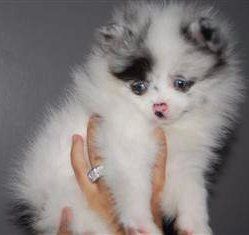
This is a super unique Pom; a merle parti.
Since merle (a splashing) is not an accepted color in many countries, though the AKC does accept it, this is rare. With white
as the primary color, this is a merle extreme piebald parti, courtesy of one of our personally recommended breeders, Lora of Pomarzzi Poms.
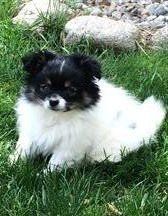
White and black parti Pomeranian with tan markings.
The tiny dashes of tan above his eyes and on his cheeks is not enough to classify this dog as a tri-color, but is rather a marking.
Kenzi
Photo courtesy of Judy Wiley
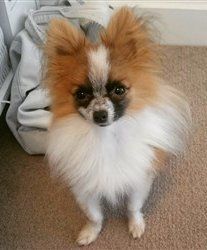
Whiteand orange parti with black mask.
You'll notice that this Pomeranian is similar to KiKi, seen above. They both have white bodies and a dark orange/red on the head, along with a blaze (the white line running over the forehead). What really sets them apart is that this Pom has a black mask. A mask (of any color) is an official marking.
Falcor, photo courtesy of Jaime Mackenzie

Black with Irish markings; With just a bit of white, this parti Pom can be registered this way. Other terms that fit is a black and white Pom or
it could be said a black Pom with white markings. This sort of placement is almost 'tuxedo marking', and would be if white was present on all legs.
KiKi, photo courtesy of Michelle Pass

Light orange and cream parti; these colors blend so nicely together. This orange is so light that it appears to be apricot.
Bamboo
Photo courtesy of Gema

Orange and white; we have to hand it to this Pom's humans for capturing this super cute & funny pic!
Thibaut, photo courtesy of Sheelagh & Durval Smith

Chocolate and white; personally, one of the most unique parti Poms that we've ever seen! A rich, super dark chocolate and crisp white.
Moji
Photo courtesy of Madelaine Lopez
Breeding for Partis
Parti is recessive to the dominant “solid” color, there for must be present again from both parents to produce a true parti.
Often parti factored dogs are accomplished by breeding a parti to a solid dog; they are often are solid with a white chest however these mis-marked dogs are capable of producing correctly marked parti pups when they are bred to another parti dog.
You may also like:
Sable Pomeranians- A wonderful type of coloring that can fall over just about any base; is quite beautiful.
Supplies You Need for a Pomeranian
- For Poms of all ages, what is needed for optimal care.
Join the PetPom Family:
This allows you to:
- Know when new pages of information are added to the site
- Be able to submit a photo of your Pom to be added to the site
- Receive a helpful & interesting Welcome Booklet
If you email photos to us, you agree that PetPom is given free copyright to use at our discretion. We will always credit the photo to the name of the Pom's owner(s) if it is supplied.
Email: Contact@PetPom.com
All text, images and artwork protected by US and International copyright laws. All rights reserved. Copyright PetPom.com
We are a participant in the Amazon Services LLC Associates Program, an affiliate advertising program designed to provide a means for us to earn fees by linking to Amazon.com and affiliated sites.

